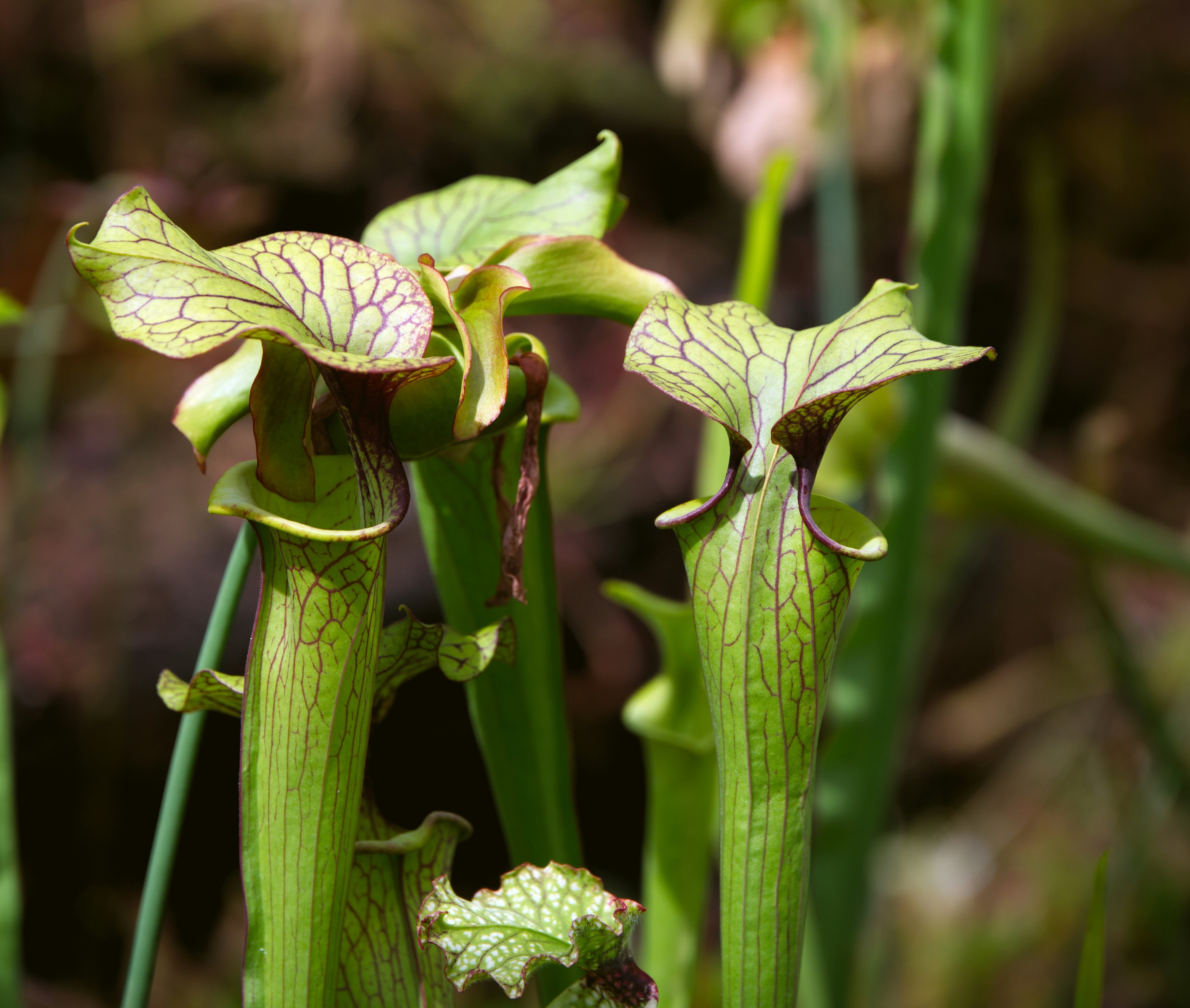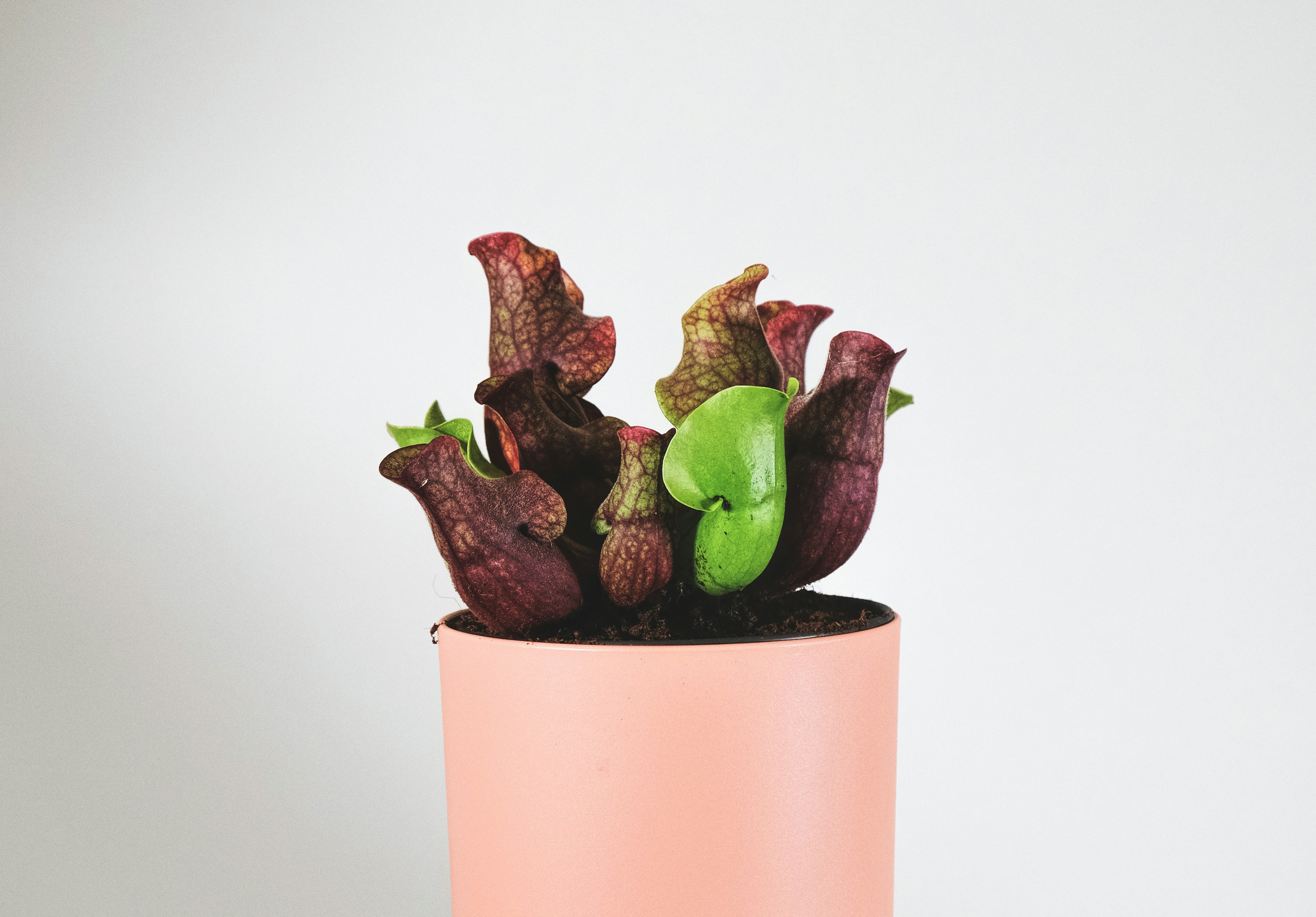Origin
There are 11 species of trumpet pitchers naturally occurring in North America. Apart from the wild forms of these plants there's also a great number of different hybrids created by hybridizers and hobbyists around the world. Many of which have very interesting colors and patterns on their pitchers.
Because these plants grow naturally in in a wide range from north to south, some species can handle cold winters better than others. Among them, the purple pitcher plant - Sarracenia purpurea - is the toughest when it comes to winter hardiness.
The scientific name of the genus, Sarracenia , is named after the Canadian botanist Michel Sarrazin.

Care
This plant can be challenging if you’re not used to growing carnivorous plants. Many would say it’s a plant that can be difficult to keep happy and thriving, and that’s true if you grow it indoors. This is due to it having some special care requirements compared to most other plants. The trumpet pitchers are best grown outside in the summer months and kept in a cool location for their winter dormancy. Given that, they're usually not that demanding.
Here is a summarized list of the most important things to keep in mind when growing a trumpet pitcher, and further below you’ll find more in-depth information about these wonderful plants' care requirements.
Don't use tap water or fertilizer to water the plant - instead use filtered water, RO-water or rainwater if you can.
Always keep the soil moist
Carefully acclimate it to direct sunlight exposure for most of the day
Keep it outdoors in summer
Give it a cool winter dormancy
Watering
The reason why these plants catch insects in order to get nutrients is due to them growing on very nutrient poor habitats. This adaptation is a good thing to keep in mind when growing a trumpet pitcher. Not only is it used to not having a lot of nutrients and minerals in the soil, but normal levels (an amount other plants would benefit from) will easily kill it. It’s therefore important to avoid both fertilizing the plant like other plants, but also to avoid using too mineral rich water - after a while even small amount of it will accumulate until it might harm the roots.
In most cases tap water has too high levels of minerals in the long run. It might not always affect the plant from the first couple of waterings but after a while the mineral content will start to build up and it could lead to it slowly starting to cause some decline in the health of the plant. Best is to use either filtered water, rain water or other water types with a lower mineral content like RO-water.
This is a plant that’s also adapted to growing in areas with constantly moist soil. So in order to make sure it grows as good as possible it’s of highest importance to make sure the soil is always moist. It’s a good idea to grow it on a saucer or tray always filled with some water, especially if growing it in a porous substrate.
Soil
Just like the importance of using mineral and fertilizer free water, it’s also important to make sure you don’t use a soil mix that contains a lot of minerals and nutrients. There are a couple of different options that work well for these plants. Pure sphagnum moss is a great alternative, unfertilized coarse peat is good too. A mix of unfertilized peat, coarse sand and perlite in equal parts is also a great mix. We call this mix “Carnivorous Plant Mix” in Planta.
These plants often come planted in rather dense peat soil from many growers. It’s an acceptable soil in the beginning but it’s often good to repot it in an airier alternative like the ones listed above once the plant has settled in your growing conditions.
These plants have rather weak root systems compared to many other plants, they also make a big stem - a rhizome - in the soil in which the plant saves energy and nutrients during the dormant period. They rarely need to be repotted due to crowded roots. It’s usually the soil decomposing and losing its porosity that causes a need for repotting the plant. When repotting it you can gently rinse the roots in water to remove the old soil. The roots are rather thick. They are brittle, so be careful when handling them and planting them in the new soil. Also make sure to keep them wet for as long as they’re exposed to the air or they will dry and get harmed easily by that too. After the repotting make sure to rinse the soil or at least hydrate it with some water.
It’s a good idea to repot the plant while it’s still dormant in late winter or spring, to cause as little stress to the plant as possible. A repotting is usually not needed every year unless the soil has decomposed a lot in that time.
Light
Just like other carnivorous plants adapted to growing in bog like environments - like venus fly traps or sundews - trumpet pitchers require plenty of bright, direct sunlight in order to grow properly and produce healthy, properly functioning pitchers. Just like any other plant it’s however important to slowly acclimate it to the sunlight. Without a slow process of letting it get used to the sunlight first, it will easily get burnt. When buying a plant it's often best to assume it's not yet acclimated to full sunlight exposure.
If you suspect that your plant isn’t used to plenty of sunlight yet the acclimation process can take a couple of weeks or even over a month until properly used to full sunlight exposure. Best is to let it eventually get used to at least 6 hours of direct sunlight, but more than that is also good. The light requirements are rather low during the dormant period when the plant often wilts at least partially down to the rhizome.
Feeding
As previously mentioned, this plant will not tolerate the addition of fertilizer to the soil. They can handle rather long periods without the addition of nutrients to the traps but regular feeding is recommended in order for it to get the best possible growth. There are some options. Apart from feeding insects to the pitchers you can also use some fish flakes or freeze dried blood worms. It’s worth noting that some fish flakes might be high in salts and they can cause some dry edges.
Plants grown outdoors will in most cases be able to catch bugs by themselves and there’s usually not as big of a need to manually feed them unless they're kept in a greenhouse or other enclosed environment.
Dormancy
Since this plant is native to temperate to subtropical wetlands it will need a period of cool temperatures in order to grow well in the long run. In fall and early winter the plant might stay green, but in most cases it will start to die back so that the pitchers start wilting from the top down. This can look bad but it’s a normal process. In the soil underneath, the rhizome will still be living and waiting for spring when it can make new healthy pitchers again.
Most cooler temperatures are good, but somewhere between 41 - 55 F ( 5 - 12 C) is preferred for most species and hybrids during the dormant period. Winter hardiness varies a bit between species and the most winter hardy ones will handle freezing with little trouble - best is however to keep them planted in the ground and covering the plants during periods of freezing temperatures.
After the dormant period the plant will start making new pitchers, and it can also start flowering if it's big enough. As long as the plant is healthy and has good growing conditions flowering doesn’t affect the growth of the plant.
Can you grow them indoors?
Yes, but it's not recommended. It’s not impossible to grow trumpet pitchers indoors but it’s harder to do it successfully compared to keeping it outdoors. The trickier aspects are the temperature, humidity and making sure it receives enough light. The temperature is hard to do much about in an indoor setting, but placing it by a cooler window or room is one option. Growing it at room temperature in the summer months is however often okay, but finding a cool enough site for the dormant period is usually the hardest part.
It’s possible to skip the dormancy for a year or so but it’s not recommended as it can affect the growth badly in the long run. A grow light is almost always necessary when keeping them indoors, especially in the darker parts of the year (if you try avoiding the dormancy altogether). Make sure it has a grow light that’s bright enough, and that it's on for about 14 h / day in that case.
